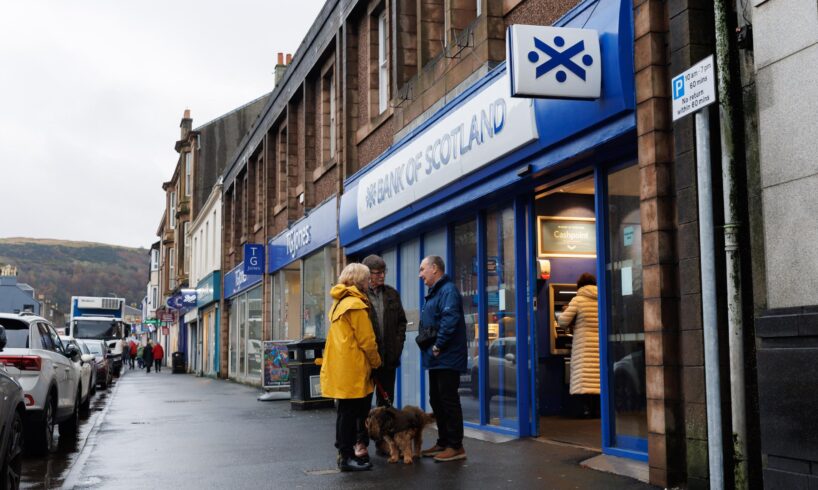
Last month, the paper had revealed that the Bank of Scotland was to close its branch on the Main Street. Today it reports a speech at Holyrood by its MSP, Kenneth Gibson. “Largs, a town of more than 11,000 inhabitants, with a sizeable number of tourists and day-trippers, will be left with no bank at all when the Bank of Scotland shuts its Main Street premises in March.”
In some other rural and coastal communities similarly abandoned by the banking conglomerates the establishment of a banking hub has softened the blow. This is where a limited facility is maintained by several banks operating on a sort of shift basis. Determining which communities qualify for this rudimentary resource falls to LINK, licensed by the UK Government to provide a network of inter-bank ATMs. This outfit sets a rather arbitrary bar where 10,000 residents must live adjacent to a town’s main thoroughfare before a banking hub will be considered. It seems that Largs doesn’t qualify because only 8,996 adults live near its centre.
Read more
In all the little places I’ve ever visited across Britain, it’s this one-size-fits-all imposition of the state’s bureaucracy that drives people round the twist more than anything else. The unique customs and circumstances of towns and villages and the people who live in them are never accorded their dignity. Mr Gibson says that his request for a review of the original cash access assessment decision about cash services was dismissed out of hand by LINK.
The men and women who operate Largs’ busy independent retail sector are deeply unhappy that the last bank has pulled out of Dodge. In the kenspeckle ‘I love Largs’ souvenir shop down near the train station I meet Roddy, the former postman who’d served this town for almost 50 years. His friend Les Ward, who owns I Love Largs, describes him as “a local legend”.
“Largs has a large number of older and retired people,” says Roddy. “Many of them aren’t very comfortable using online banking and get anxious if they can’t remember a password.”
He points to a shopfront just along the road beside the bus-stop. “I can remember a time when Largs had six banks on the Main Street. The Royal Bank of Scotland were in there until recently. Now it’s been taken over by Greggs the bakers. The place where you could get a mortgage or an overdraft will now be providing you with sausage rolls and steak bakes. Maybe it’s a sign of the times we’re living in.”
Mr Ward and his family have been in this space for almost 40 years. It’s often the first spot for holiday-makers or day-trippers when they visit Largs. The town is only around 30 miles from Glasgow and a direct train service delivers you straight into the heart of Largs.
Largs attracts many day-trippers and older visitors (Image: Colin Mearns)
“More than 90% of my customers are people coming here for a holiday or a day out,” he says. “They tend to use cash as it means they can keep to their budget for the day much more easily. The age profile of Largs is largely in the over-55 category and it’s just a fact of life that many of them like to deal with the people who look after their money on a personal basis.”
Mr Ward also runs Gillian’s Saltire Appeal, a popular local cancer charity named in honour of his late wife. He points out an apartment at the other end of the street which gives incomparable views over the water to Millport. The charity owns this flat and provides it free of charge to cancer patients and their families. He gives me a tour of his premises, including an upstairs floor rammed with signed football and golfing memorabilia which will be auctioned for Gillian’s.
“When people visit the shop, they’ll drop in cash donations for the charity which our volunteer staff will deposit in the Bank of Scotland across the road. When that branch closes next March, they’ll have to queue at a very small Post Office where other people must go for their own essential business. I don’t see how they can refuse to set up a banking hub at least.”
All those High Street banks now abandoning Scotland’s rural or disadvantaged neighbourhoods seem impervious to their unique financial needs. For them, a community is only as good as the profits which can be squeezed from it. The less time they actually have to spend dealing with the punters face to face, the better. No matter how absurdly gigantic are their profits, the notion of providing any kind of service freely for the common good is an alien one.
Such financial conduct regulations as there are in the UK oblige them only to avoid committing fraud and for their transactions to be legal. When the big life-changing events occur like redundancy, divorce and sickness occur, the ability of poor people to navigate them are judged purely by numbers on a screen. They are stripped of all rights and means to plead their case.
Bank of Scotland owner Lloyds Banking Group is Britain’s largest mortgage lender. It reported, what Scottish Financial News, called “eye-watering” annual profits during 2023, benefitting from higher interest rates. Its pre-tax profit of £7.5Bn, represented a 57 per cent year-on-year increase exceeded analysts’ expectations and marked a record high in profits. The same analysts though, suggested that the following year could be a bit ‘bumpy’ owing to exposure to historic car finance selling practices.
Les Ward owns the I Love Largs souvenir and gift shop (Image: Colin Mearns)
This is what ‘bumpy’ looks like. The influential Scottish Financial News website reported that the group’s pre-tax profit for the third quarter of this year fell by 36% to a mere £1.17Bn. The decline, it said, was driven by total costs swelling 37% to £3.18bn, which included an £800 million charge for the motor finance issue. Such is the eternal and untouchable profitability of the major banks that they can reduce big financial bumps to pebbles.
They set profit margins on which the viability of small branches are solely judged. No other metric can be considered. The fixed annual salary of the Lloyd’s Group Chief Executive is £2.5m with the potential to trouser another million or so in bonuses.
Last year, data from the British Banking Association and the Office for National Statistics (ONS) showed an astonishing decline in banks on Britain’s high streets. In 1986 there were 21,643 bank and building society branches in the UK, compared to 6,870 by the end of 2024. The criteria by which they decide to close a branch conforms to principles that take no account of the needs of those communities from which they’ve squeezed every ounce of profit over many years.
Age Scotland has highlighted how this has led directly to a deficiency that’s disproportionately felt in some local communities and by vulnerable groups. The charity said that planned closures particularly in rural and remote areas could further isolate those already at risk of being cut off from society. It said: “Banks, just like libraries and post offices, are vital services in our communities. “They provide people with information, they encourage older people to get out and about and they help tackle loneliness and isolation. The fact that many of them are closing down will disadvantage many older people.”
Earlier this year, it was reported that more than one in three of the latest branch closures announced by the Bank of Scotland would affect the south of the country. Branches in Annan, Moffat, Peebles, Thornhill and Sanquhar will all be shut by early next year. The sole justification for leaving these places, according to the Lloyds Group is that most people now bank online and that “alternative provision” will be organised.
In the Outlet Clearing Shop at the other end of Largs, Brian the proprietor points across the road to the condemned Bank of Scotland branch. “Even at this time on a midweek day, it’s busy,” he says. “Older people feel less anxious when they can actually speak to the people who they trust to hold their money.”
Kevin McKenna is Scotland’s Feature Writer of the Year





